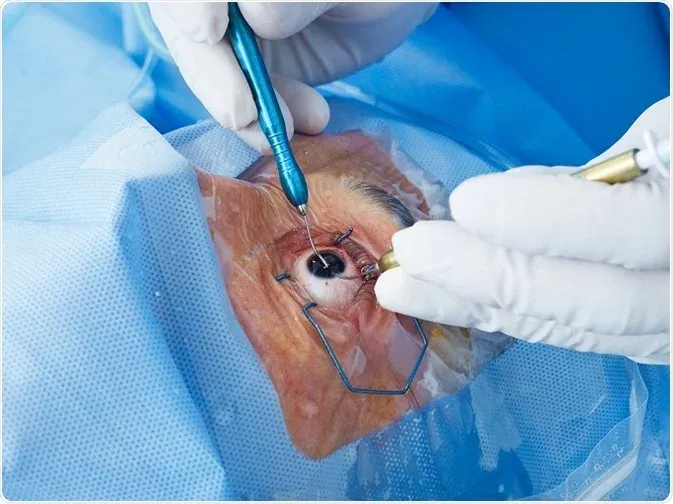Eye Surgery
Innovations in Eye Surgery: Cutting-Edge Techniques Transforming Vision Care
FSDAVCFEBFEVSDDVFSD
FSDAVCFEBFEVSDDVFSD
FSDAVCFEBFEVSDDVFSD
Latest Eye Surgery Techniques: A Glimpse into Modern Ophthalmology
The field of eye surgery has seen remarkable advancements in recent years, particularly in procedures like LASIK and cataract surgery. These eye surgery innovations have significantly improved patient outcomes, making surgeries safer and more effective. Understanding these latest eye surgery techniques can help patients make informed decisions about their vision correction surgery options.
Innovations in LASIK technology have included the use of femtosecond lasers, which create precise corneal flaps without the need for a blade, enhancing safety and accuracy. Wavefront-guided and topography-guided LASIK provide personalized treatments by mapping the eye's unique imperfections, leading to better visual outcomes and reduced side effects like glare and halos.
The field of eye surgery has seen remarkable advancements in recent years, particularly in procedures like LASIK and cataract surgery. These eye surgery innovations have significantly improved patient outcomes, making surgeries safer and more effective. Understanding these latest eye surgery techniques can help patients make informed decisions about their vision correction surgery options.

Innovations in LASIK technology have included the use of femtosecond lasers, which create precise corneal flaps without the need for a blade, enhancing safety and accuracy. Wavefront-guided and topography-guided LASIK provide personalized treatments by mapping the eye's unique imperfections, leading to better visual outcomes and reduced side effects like glare and halos.

Advancements in LASIK Surgery: Achieving Clearer Vision with Laser Precision
One significant advancement in LASIK surgery is wavefront-guided technology. This method uses detailed mapping of the eye's imperfections to create a highly personalized treatment plan. By addressing specific irregularities in the cornea, wavefront-guided LASIK provides more precise vision correction surgery. Patients often experience better visual outcomes and fewer issues such as glare and halos compared to traditional LASIK.
Another key innovation is the use of femtosecond lasers in LASIK. These lasers replace the traditional microkeratome blade used to create the corneal flap. Femtosecond lasers offer greater accuracy and safety, reducing the risk of complications. The precision of these lasers allows for a more controlled and predictable procedure, leading to improved patient satisfaction and quicker recovery times.
These advancements in LASIK surgery have significantly improved patient outcomes. With wavefront-guided LASIK and femtosecond lasers, patients benefit from enhanced vision quality and a smoother recovery process. The combination of these technologies results in fewer complications and a higher overall success rate for LASIK procedures.
Improving Cataract Surgery: Revolutionary Methods for Better Vision Restoration
Femtosecond laser-assisted cataract surgery (FLACS) represents a significant advancement in precision. This technology uses a femtosecond laser to make precise incisions and fragment the cataract-affected lens. The laser's accuracy reduces the need for manual incisions, leading to better visual outcomes and faster recovery times. FLACS can also reduce the risk of complications such as corneal swelling and postoperative infections.
Modern Intraocular Lenses (IOLs): Enhancing Vision After Cataract Surgery
Modern intraocular lenses (IOLs) have greatly improved post-surgery vision. These lenses, such as multifocal and extended depth-of-focus (EDOF) IOLs, provide clear vision at multiple distances, reducing or eliminating the need for glasses. Innovations in IOLs allow for more customized vision correction, addressing specific needs like astigmatism with toric IOLs. This advancement enhances patient satisfaction and quality of life after cataract surgery.
The Role of Advanced Eye Health Technology in Modern Surgery
Advanced eye health technologies, like optical coherence tomography (OCT), play a crucial role in cataract surgery. OCT provides detailed, real-time imaging of the eye, allowing surgeons to plan and execute advanced eye procedures with high precision. This technology helps in creating accurate surgical plans tailored to each patient's unique eye structure, improving overall surgical outcomes.
Advanced eye health technologies, like optical coherence tomography (OCT), play a crucial role in cataract surgery. OCT provides detailed, real-time imaging of the eye, allowing surgeons to plan and execute advanced eye procedures with high precision. This technology helps in creating accurate surgical plans tailored to each patient's unique eye structure, improving overall surgical outcomes.
Benefits of Digital Surgical Microscopes: Precision and Clarity in Eye Surgery
Digital surgical microscopes enhance the visualization of the surgical field, offering high-definition images during cataract surgery. This technology aids in performing minimally invasive procedures, leading to shorter recovery times and better visual results. The precise imaging capabilities help surgeons to conduct more accurate and effective surgeries, thus improving patient outcomes.
Eye Health Technology: Transforming the Field of Ophthalmology

Optical coherence tomography (OCT) is a non-invasive imaging technique used in eye surgery. OCT provides detailed cross-sectional images of the retina, allowing surgeons to see the retina's layers with high precision. This technology is crucial in diagnosing and monitoring various eye conditions, including glaucoma, macular degeneration, and diabetic retinopathy.
During surgery, OCT helps in creating precise surgical plans by offering real-time, three-dimensional views of the eye’s internal structures, which ensures more targeted and effective treatments.
Optical coherence tomography (OCT) is a non-invasive imaging technique used in eye surgery. OCT provides detailed cross-sectional images of the retina, allowing surgeons to see the retina's layers with high precision. This technology is crucial in diagnosing and monitoring various eye conditions, including glaucoma, macular degeneration, and diabetic retinopathy. During surgery, OCT helps in creating precise surgical plans by offering real-time, three-dimensional views of the eye’s internal structures, which ensures more targeted and effective treatments.

In addition to aiding in surgical planning, OCT enhances post-operative care by allowing surgeons to track the healing process and detect any complications early. The high-resolution imaging provides critical insights into the success of the procedure and helps in adjusting treatment plans if needed.
Digital Surgical Microscopes: Enhancing Surgical Precision and Outcomes
Digital surgical microscopes have significantly improved outcomes in eye surgeries. These microscopes provide high-definition visualization of the surgical field, allowing surgeons to perform minimally invasive procedures with greater accuracy. The enhanced imaging capabilities help in reducing the risk of complications and lead to faster recovery times for patients. This technology is particularly beneficial in complex procedures like cataract surgery, where precision is paramount for successful outcomes.
Impact on Patient Outcomes: How Advanced Techniques Improve Vision Surgery Results
Advancements in eye surgery have greatly improved patient outcomes and success rates. Innovations like femtosecond laser-assisted surgeries provide higher precision, resulting in safer procedures and quicker recovery times. For example, using lasers in cataract surgery reduces the risk of complications and enhances visual acuity, allowing patients to see more clearly and return to their daily activities sooner.
The use of advanced imaging technologies, such as optical coherence tomography (OCT), helps surgeons create precise surgical plans tailored to each patient. This personalization leads to fewer post-operative complications and better overall results. Additionally, new intraocular lenses (IOLs) designed for cataract surgery improve vision at multiple distances, often eliminating the need for glasses. These advancements are transforming eye care, providing patients with more reliable and effective treatment options.
Future Directions in Eye Surgery: Innovations on the Horizon
Artificial intelligence (AI) is becoming a significant tool in eye surgery. AI helps in creating personalized treatment plans by analyzing vast amounts of patient data. For example, AI can predict how a patient's eye will heal after surgery, which improves the precision and outcomes of procedures like LASIK and cataract surgery. AI also assists in real-time decision-making during surgery, enhancing the safety and effectiveness of the operations.
Innovations in Intraocular Lenses (IOLs): The Next Generation of Vision Enhancement
New materials and designs for intraocular lenses (IOLs) are being developed to further improve vision correction. These advancements include multifocal and extended-depth-of-focus IOLs, which help patients see clearly at multiple distances without the need for glasses. Light-adjustable lenses (LALs) are another innovation, allowing surgeons to fine-tune the lens power after implantation using UV light. These advancements aim to provide better vision outcomes and greater patient satisfaction.
Ongoing Research and Development in Eye Surgery: Pioneering New Frontiers
Research in eye surgery continues to drive innovations. For instance, the development of AI-powered phaco machines is improving the precision and safety of cataract surgery. These machines provide real-time feedback to surgeons, reducing the risk of complications. Additionally, new imaging technologies like advanced OCT are enhancing the ability to diagnose and treat eye conditions more effectively. These advancements are making eye surgeries safer, more precise, and more successful.
Improving Patient Outcomes: The Benefits of Modern Eye Surgery Techniques
Future advancements in eye surgery will continue to improve patient outcomes. The integration of AI and new technologies in surgical planning and execution will lead to more accurate and safer procedures. Innovations in IOLs and other surgical tools will enhance the quality of vision correction, providing patients with better results and quicker recovery times. As research progresses, patients can expect even more effective and personalized eye care solutions.
Choosing the Right Procedure: A Guide to Eye Surgery Options and Benefits
Choosing the right eye surgery procedure involves careful consideration and consultation with an eye care provider. An expert evaluation is essential to determine the most suitable procedure based on your specific needs, eye health, and lifestyle. For instance, LASIK and SMILE are popular options for vision correction surgery, each offering unique benefits.
LASIK involves creating a corneal flap and is effective for correcting a wide range of refractive errors, including myopia, hyperopia, and astigmatism. It offers quick recovery times and precise results. On the other hand, SMILE is a minimally invasive procedure that uses a smaller incision and does not require a corneal flap, making it suitable for those with thin corneas and those involved in contact sports.

Choosing the right eye surgery procedure involves careful consideration and consultation with an eye care provider. An expert evaluation is essential to determine the most suitable procedure based on your specific needs, eye health, and lifestyle. For instance, LASIK and SMILE are popular options for vision correction surgery, each offering unique benefits.

LASIK involves creating a corneal flap and is effective for correcting a wide range of refractive errors, including myopia, hyperopia, and astigmatism. It offers quick recovery times and precise results. On the other hand, SMILE is a minimally invasive procedure that uses a smaller incision and does not require a corneal flap, making it suitable for those with thin corneas and those involved in contact sports.
Final Words
Staying informed about the latest advancements in eye surgery is vital for achieving better patient outcomes. Innovations like wavefront-guided LASIK, femtosecond lasers, and advanced intraocular lenses significantly enhance the precision, safety, and effectiveness of procedures. These advancements not only improve visual acuity but also reduce recovery times and the risk of complications.
Considering advanced procedures for vision correction can greatly enhance your quality of life. Modern techniques offer personalized treatments tailored to individual needs, ensuring optimal results. By consulting with an eye care provider, you can determine the best surgical option to achieve clearer vision and long-term eye health. For more information and to schedule a consultation, visit Kleinwood Vision.

Contact Info
Hours of Operation
Mon - Fri | 9:00 AM - 5:00 PM
Sat - Sun | Closed
Holiday Hours: We are closed for the following holidays: New Years Day, Memorial Day, Independence Day, Labor Day, Thanksgiving Day, Christmas Day
© 2025 Kleinwood Vision. All rights Reserved.


